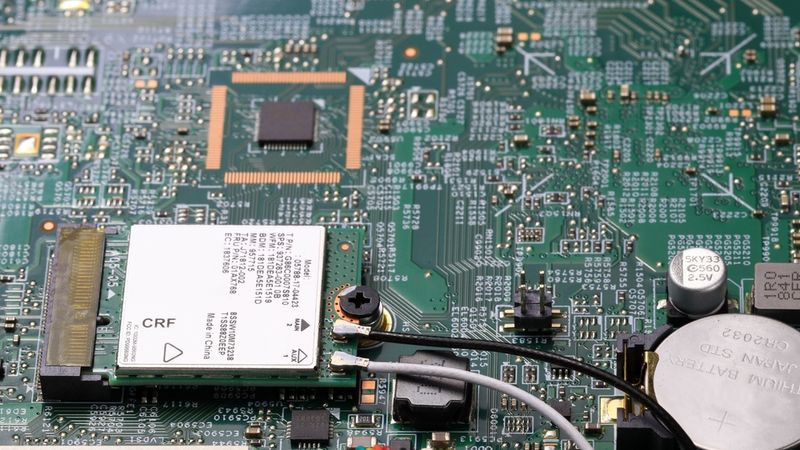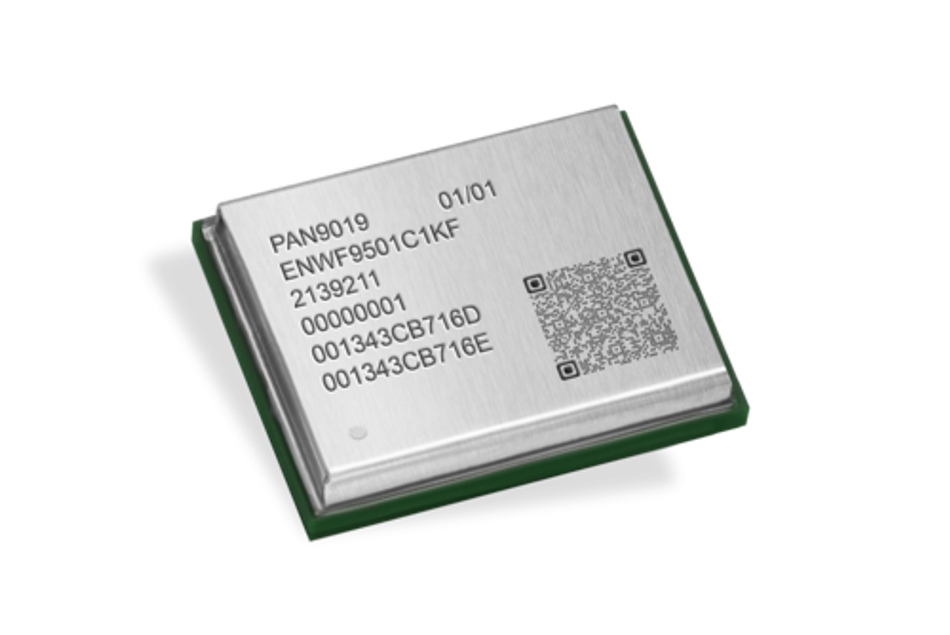Upgrade to the latest Wi-Fi standards quickly and simply by using pre-certified modules
Designing a Wi-Fi front end module using a wireless SoC based on the new Wi-Fi standards can be complex and costly, so choosing a pre-certified module is the most straightforward way to get to market quickly.

In case you missed it, there are new iterations of Wi-Fi that change the discussion from individual radio link performance to network performance. Many new techniques have been introduced in Wi-Fi 6, Wi-Fi 6E, and the soon-to-be-ratified Wi-Fi 7 standards that improve performance, at both device and network levels. Designing a Wi-Fi front end module using a wireless SoC based on the new Wi-Fi standards can be complex and costly, so choosing a pre-certified module is the most straightforward way to get to market quickly.
When laying out a PCB containing a high-performance, miniature wireless SoC, every detail is important - from signal integrity on the high-speed digital I/O bus carrying data to the transceiver, to impedance-matching between the RF output pin and antenna. It requires specialised RF expertise to identify issues early and avoid difficulties later. Also, Wi-Fi development requires expensive test equipment. By contrast, the radio design has already been optimised in a module, which can also help remove hassles from the development cycle. This leads to substantial cost savings.
Certification is expensive
Products shipped with a transmitter need to ensure that they function in harmony with other devices in a shared environment. The harmony is achieved by the path of certification of these products following stringent testing of the radio according to locally applicable regulations. Of course, this also applies on products containing a Wi-Fi transceiver. Infact, the costs of going through a full certification tends to be more expensive for Wi-Fi, given the nature of the technology. A Wi-Fi product needs to have an optimal radio behavior when placed next to other products in the same or different but co-located Wi-Fi networks. Additionally the Wi-Fi product must also guarantee that it doesn’t interfere with other ISM band technologies like Bluetooth, Zigbee, Thread or other proprietary wireless stacks. Furthermore, a badly designed Wi-Fi device is highly susceptible to disturb or be disturbed by LTE Cellular radios, or radars operating in 5 GHz bands for use in civil or military applications.
The situation has been further exacerbated by the global discord on how to use 6 GHz band in context of ISM band technologies like Wi-Fi and Bluetooth. For example, while the United States has permitted the entire 1200 MHz bandwidth to be used for ISM applications, the European Union has only opened 480 MHz in the lower 6 GHz band. Navigating worldwide regulatory hurdles often ends up being the single biggest hidden cost in the hardware design. Working with test labs to pass the regulatory testing is an additional effort. All of this adds to the overall development cost. The use of pre-certified wireless modules removes much of the pain. System designers simply reuse the licence issued to the module maker to safely integrate the wireless function.
Choosing the right Wi-Fi module
The choice of Wi-Fi module can be guided by many different factors, including:
Architecture
A module may have an open application processor to host the network stack, as well as the embedded IoT application, all running in context of a constrained RTOS. Or the module might act as a network co-processor (NCP) that handles the Wi-Fi communication but requires a host processor for network handling. The latter most often requires a full operating system (Windows or Linux). However, increasingly, device vendors are also capable of interfacing NCP with a TCP/IP stack running over some form of real-time OS (e.g. FreeRTOS).
Multiple wireless protocols
A project may require an assortment of connectivity options. Depending on the role to be executed, one can choose from a single-protocol, Wi-Fi-only module, to a multi-protocol solution that supports Bluetooth and 802.15.4-based mesh connectivity. For a small premium, the multi-protocol solution offers tight integration and better handling of coexistence compared to a discrete multi-SoC/module solution.
Figure 1 PAN9019 - a certified radio module containing dual band WiFi 6 and Bluetooth 5.4 sub-systems.
Communication Interfaces
Each device and application has its own unique wireless connection capability and requirement. While one device must pump multiple gigabits through a wireless link for streaming 4k video, another device may find a few kilobits more than adequate to report sensor data, or to remotely operate an actuator. The available options mirror the diversity of applications. So, there are wireless modules that support high-speed communications interfaces like SDIO and PCIe that are suitable for very high-throughput data pump applications, while other solutions are optimised for power-constrained applications using interfaces like SPI, I2C and UART to connect sensors.
Antenna Choices
The antenna is an important consideration in a wireless design. It acts as a transducer that converts currents and voltages received from the transceiver into electromagnetic energy radiated out by wireless – and vice versa. A sub-optimal antenna can render a product entirely unusable. This is why the choice of the antenna is often dictated by the design of the end product. While some designers prefer compact antennas designs integrated within the PCB, others use external terminal-mounted antennas for improved coverage. One must remember that the antenna is an integral part of the radiator set-up, and is therefore explicitly linked to wireless module regulatory certification. Lesson: look at the fine print when choosing an antenna! Modules may come with an onboard antenna, or with a certified reference design that allows users to copy the exact design and reuse the certification grant. The end goal is always to achieve optimal radio coverage for a given design, which may require modification to antennas and associated certification.
What to expect from a Wi-Fi module vendor
In IoT, Wi-Fi implementation is often critical. Therefore, a module vendor needs to deliver certain core values:
Hardware design support
RF designs can often throw up nasty surprises, just when they are least expected. It is at this stage that support from engineers with valuable experience in designing Wi-Fi modules is crucial to achieve a quick design cycle. A module vendor can support in various ways: reviewing PCB layout; matching the input impedance of the antenna; recommending module or antenna placement for better coverage; etc.
Adding new regulatory domains and antennas
As mentioned earlier, ease of achieving regulatory certification of the radio functionality is one of the primary benefits of using Wi-Fi modules. Therefore, vendors should have a broad regulatory strategy to ensure design flexibility, including multiple domains to cover more markets; and multiple antenna types.
In some cases, a certified antenna on the module may be inadequate for the radio performance required, necessitating a different antenna than that which has been certified. In other cases, a product may be targeting a new market for which the module vendor does not hold a grant and/or test reports. In such cases, a module vendor’s support is needed to add a new regulatory domain to the list of pre-existing certifications, or to certify a completely new antenna type. Module vendors can support by testing for new regulations, issuing an authorised notice-of-change to the original granted certification.
Software troubleshooting
Wi-Fi driver integration on an embedded platform is one of the most important topics during the entire software life cycle of the project. Let’s take the example of an NCP for a Linux-based embedded device. It is common practice for wireless semiconductor vendors to issue periodic releases of drivers tested against the latest stable version of the Linux kernel. Also, the wireless drivers need to be patched for security vulnerabilities. Upgrading to a new release, especially in the case of wireless devices with ‘out-of-tree’ drivers, may sometimes lead to a product experiencing unexpected behaviour. It is here that support from a module vendor, either through communication about the discovery of a vulnerability and availability of security patches, or by actively troubleshooting and doing root-cause analysis of error during driver integration, can go a long way to smooth project management. The same is also true for a wireless module designed around an embedded wireless microcontroller.
Ensuring full supply chain support
Poor vetting of the supply chain can ruin an otherwise exceptional PCB design. Lacking even a small and seemingly inconsequential component like a resistor may hold up production, but an alternative should be available. However, a certified radio module is one of the most critical components as it is intrinsically associated with end-product declarations made by the manufacturer to the regulatory bodies. Consequently, redesigning the product may not be possible – certainly it will be a very costly affair. This is where the full support of a capable and committed module vendor brings tangible value to the table. Topics may include: technology consulting to understand best platform design; product lifecycle management; and production forecasting. Factory audits to build transparency in the supply chain may be required.
Panasonic Industry Europe
Panasonic Industry Europe is a renowned supplier of short-range wireless connectivity solutions with a portfolio comprising Wi-Fi, Bluetooth and other networking technologies. Its wireless modules and NICs are radio-certified for multiple regulatory domains including the United States, Europe, Canada, Japan and other countries in Asia-Pacific. Furthermore, these regulatory certifications encompass many different types of antenna types, with reference antennas certified from multiple reputable antenna vendors The company further enables IoT projects through an ecosystem of partners that address antennas, embedded firmware and proprietary wireless stacks.
Panasonic’s wireless module portfolio covers multiple generations of Wi-Fi from Wi-Fi 4 to Wi-Fi 6/6E solutions. Wi-Fi 7 modules are part of the future roadmap. Its modules are designed and produced in Europe in a facility wholly owned by Panasonic.
table
Product | PAN9028 | PAN W602-1x | PAN9019(A) | PAN W601-1x |
RF Category | Wi-Fi 5 and Bluetooth 5 | Wi-Fi 6 and Bluetooth 5 | Wi-Fi 6 and Bluetooth 5 (and IEEE® 802.15.4) | Wi-Fi 6E and Bluetooth 5 |
Frequency [GHz] | 2.4 and 5 | 2.4 | 2.4 and 5 | 2.4, 5 and 6 |
Chip | NXP – 88W8987 | TI – CC3301 | NXP – IW611/2 | Synaptics – SYN43711 |
Certified antenna | Integrated chip/Terminal (via bottom pad) | Integrated chip/bottom pad options (tbd) | Via bottom pad: chip/ (Flex)PCB/Terminal | Integrated chip/bottom pad options (tbd) |
Regulatory certifications | CE RED, FCC, ISED | CE RED, FCC, ISED, MIC* | CE RED, FCC, ISED, MIC, RCM | CE RED, FCC, ISED, MIC* |
Size [mm] | 24.0 x 12.0 x 2.8 | 12.9 x 9.5 x 1.8* | 15.3 x 12.0 x 2.5 | 12.2 x 9.9 x 2.55* |
Status | Mass production | Under development | Mass production | Under development |
To learn more see |
Table 1: Panasonic's latest Wi-Fi modules for new designs

